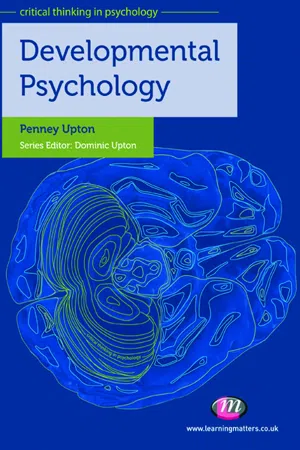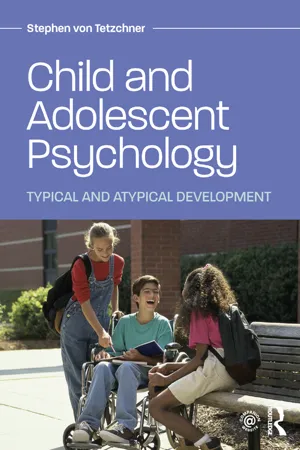Psychology
Prenatal Physical Development
Prenatal physical development refers to the process of growth and changes that occur in an unborn baby from conception to birth. This includes the development of organs, limbs, and sensory abilities. Prenatal physical development is influenced by genetic factors, maternal health, and environmental factors, and it is a critical period that lays the foundation for a child's future health and well-being.
Written by Perlego with AI-assistance
Related key terms
5 Key excerpts on "Prenatal Physical Development"
- eBook - ePub
Child Development
A Practical Introduction
- Kevin Crowley(Author)
- 2017(Publication Date)
- SAGE Publications Ltd(Publisher)
4 Physical and Brain DevelopmentBy the end of this chapter you should
- have a basic understanding of prenatal development
- have a basic understanding of the physical changes that take place during childhood and be familiar with factors related to those changes
- understand the distinction between fine and gross motor skills and be aware of how these skills develop
- be familiar with the basic structure of the brain and understand some of the key concepts and terminology related to brain development
- understand how the environment in which the child is raised plays a crucial role in physical growth and the development of the brain.
Why you should read this chapterA great many physical changes take place over the course of childhood. It is tempting to think of physical growth and brain development as a process that happens naturally if a few basic conditions are met, such as being provided with adequate nutrition. There is undoubtedly a pre-programmed element to biological development; however, as you will see from this chapter, the development of the brain and even physical growth itself are affected significantly by the child’s experience as well and require more than just satisfying certain conditions. The provision of a stimulating and emotionally caring environment also plays a crucial role in biological development in childhood.Prenatal development
The nine-month period between conception and birth is divided into three stages: the germinal stage, which covers the first two weeks after conception; the embryonic stage, which lasts from the third to the eighth week; and the foetal stage, which lasts from nine weeks to birth. The following sections summarise some of the main developments at each stage, based on the accounts of prenatal development provided by Berk (2008) and Moore and Persaud (2003).The germinal stage
Conception occurs when the egg and sperm unite to form a single cell called a zygote. The zygote then journeys from the fallopian tubes to the uterus and the process of cell division begins: the zygote divides into two cells, then into four cells, sixteen cells, and so on. By about the fourth day, the zygote is now a hollow, fluid-filled ball called a blastocyst. The cells on the inside of the blastocyst form the embryonic disk that will become the new organism. The outer layer of the blastocyst is called the trophoblast and this will combine with cells in the uterus to form the structures that will protect and nourish the developing organism. Between the seventh and ninth days, the blastocyst begins to implant in the wall of the uterus. The trophoblast starts to multiply rapidly and first forms a protective membrane called the amnion, which encloses the organism in amniotic fluid. This fluid maintains a stable temperature and also acts as a cushion again jolts caused by the mother’s movements. A yolk sac also develops that produces blood cells. In the second week of this state the cells of the trophoblast form a second protective layer called the chorion - eBook - ePub
- Penney Upton(Author)
- 2011(Publication Date)
- Learning Matters(Publisher)
Chapter 2 Prenatal development, birth and the neonateLearning outcomes
By the end of this chapter you should:– be able to describe the main stages of prenatal development;– understand the factors influencing prenatal development;– be able to evaluate how the environment and genetics interact to influence development;– be aware of the main threats to typical prenatal development;– be able to evaluate critically the evidence concerning prenatal learning and later cognitive development;– understand critically the importance of social and cultural factors surrounding the birth process;– have developed your ability to analyse and evaluate written text;– have developed your organisational skills and visual communication.Introduction
During the prenatal period, many of the foundations for later development are established. It is therefore important to know what happens during the main stages of prenatal development and this is the starting point for this chapter. Physical maturation of the unborn child is described and the genetic factors that influence this early development are presented.However, it is also important to remember that you are studying psychology, not biology. Consideration must be given to the long-term impact of prenatal experiences on later social, emotional and psychological development. For this reason, the focus of prenatal development in psychology tends to be on how development may be negatively affected by environmental factors such as teratogens , and on the short- and long-term consequences for child development. Of course, the flip side of this is the way in which avoidance of teratogens can be beneficial for future infant well-being. The sort of advice that could be given to expectant parents in order to give their child the best developmental opportunities should therefore be considered. Other important environmental factors that are discussed include the social and cultural context in which development occurs and, especially, how this might impact on the perinatal experiences of the neonate - eBook - ePub
Child Development
Concepts and Theories
- Jean A. Mercer(Author)
- 2018(Publication Date)
- SAGE Publications Ltd(Publisher)
Typical development does not mean that a baby is necessarily at an average level of growth, because there are normal individual differences in babies, and one who is quite a bit bigger or smaller than the average may still be very much within the normal range, giving no cause for concern. Although the developmental changes in the baby and in Sophia may be affected by environmental factors, and although the support of the environment is needed to maintain life and development, maturation plays the major role in determining how development proceeds. Concepts Specific to the Prenatal Period Prenatal Growth and Development As a baby develops from conception to the time of birth, the mother is also experiencing her own developmental change as her body alters through pregnancy, a period during which she gains weight as her uterus and breasts grow along with the growth of the baby. This is an important period in the mother’s own physical and psychological development, but because the topic of this book is child development, pregnancy will not be the focus here. Instead our concern will be with gestation, the events and processes that change the single cell of a fertilized ovum to the complex, multicellular organism, weighing at least several pounds, that emerges at birth many months after conception. In talking about events during gestation, it can be helpful to use the terms prenatal (referring to the period between conception and birth), perinatal (referring to the time just before, during, and soon after birth), and postnatal (after birth). These terms emphasize the concept of birth as a discontinuity in the process of development, with events before and after birth having somewhat different natures; however, continuity of development, with similar processes at work from the prenatal to the postnatal period and later, is an important theme in the study of child development - Stephen von Tetzchner(Author)
- 2022(Publication Date)
- Routledge(Publisher)
Fetal development is complex, and the interpretation of causal relationships in these types of studies is associated with considerable uncertainty. Statistical correlation says nothing about what is cause and what is effect. Development is transactional during fetal life as well (DiPietro, 2010). Depression and anxiety can lead mothers to smoke and drink more alcohol, substances which can affect the development of the fetus (see Chapter 8, this volume). Mothers with fetuses that are active or have developmental anomalies can experience pregnancy as more stressful. Studies showing increased stress in mothers of children with Down syndrome or cleft palate point in this direction (Drillien & Wilkinson, 1964; Stott, 1973). Such conditions cannot possibly have been triggered by the mother’s emotional state. Furthermore, mothers who are depressed or stressed during pregnancy tend to maintain these states after birth. It is therefore difficult to separate the effects of stress during pregnancy from the consequences of the mother’s stress level and possible interaction problems during the child’s first months of life (Field, 2011; Mulder et al., 2002).It is sometimes argued that experiences during a normal birth can have a profound effect on children’s development and lead to mental problems later in life (Winnicott, 1992). There is no scientific support for such claims, and others argue that the powerful forces associated with labor and delivery fulfill an adaptive role that helps the newborn child begin to function independently and thereby eases the transition from fetus to infant (Hepper, 1992; Ronca & Alberts, 1995).Summary of Part II
- Development begins at conception. The characteristics and abilities of a child at birth emerge as the result of 9 months of development. The germinal period consists of the first 10 days. The 6 weeks following the germinal period are called the embryonic period, while the fetal period lasts until the child is born.
- Several diseases can affect fetal development. In addition to the mother’s use of alcohol, tobacco and drugs, chemical substances in the environment have also proved to be of importance. The particular effect of various substances depends on when and for how long the fetus has been exposed to them.
- The sensory systems develop in a fixed order, and all senses are functional by week 26. Gradually, the fetus changes in its reactions to stimulation.
- eBook - ePub
Child and Adolescent Psychology
Typical and Atypical Development
- Stephen von Tetzchner(Author)
- 2018(Publication Date)
- Routledge(Publisher)
7 It is assumed that the course of fetal development has a certain bearing on the child’s future development, “fetal programming” and epigenesis. There is a certain continuity in fetal activity, and a correlation between fetal reactions to stimulation and temperament during infancy. This can increase the probability of children attending to their own mother.8 The mother’s emotional state during pregnancy can affect the child’s later development. For example, there is a relationship between the mother’s emotions and fetal growth and activity, especially during the first part of fetal development, but the correlations are generally small and it is difficult to distinguish prenatal influences from later ones. On the other hand, fetuses whose mothers react more emotionally to different situations may have a more varied and stimulating physiological environment. Fetal development is complex and the interpretation of causal relationships in these types of studies is associated with considerable uncertainty.9 There is no scientific support for the claim that particular experiences during birth can have a profound effect on a child’s development and lead to psychiatric disorders later in life.CORE ISSUES
• The influence of fetal experiences on later development.• The influence of the mother’s mental state on the fetus and the child’s later development.SUGGESTIONS FOR FURTHER READING
Behnke, M., Smith, V. C., & Committee on Substance Abuse (2013). Prenatal substance abuse: Short- and long-term effects on the exposed fetus. Pediatrics, 131, e1009–e1024.James, D. K. (2010). Fetal learning: A critical review. Infant and Child Development, 19, 45–54.O’Connor, T. G., Monk, C., & Fitelson, E. M.. (2014). Practitioner review: Maternal mood in pregnancy and child development–implications for child psychology and psychiatry. Journal of Child Psychology and Psychiatry, 55
Learn about this page
Index pages curate the most relevant extracts from our library of academic textbooks. They’ve been created using an in-house natural language model (NLM), each adding context and meaning to key research topics.




